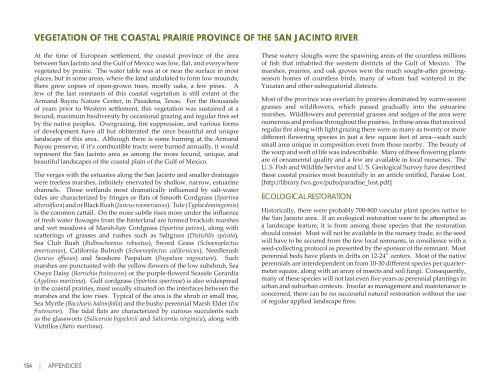design elements - San Jacinto Texas Historic District
design elements - San Jacinto Texas Historic District
design elements - San Jacinto Texas Historic District
You also want an ePaper? Increase the reach of your titles
YUMPU automatically turns print PDFs into web optimized ePapers that Google loves.
VEGETATION OF THE COASTAL PRAIRIE PROVINCE OF THE SAN JACINTO RIVER<br />
At the time of European sett lement, the coastal province of the area<br />
between <strong>San</strong> <strong>Jacinto</strong> and the Gulf of Mexico was low, fl at, and everywhere<br />
vegetated by prairie. The water table was at or near the surface in most<br />
places, but in some areas, where the land undulated to form low mounds,<br />
there grew copses of open-grown trees, mostly oaks, a few pines. A<br />
few of the last remnants of this coastal vegetation is still extant at the<br />
Armand Bayou Nature Center, in Pasadena, <strong>Texas</strong>. For the thousands<br />
of years prior to Western sett lement, this vegetation was sustained at a<br />
fecund, maximum biodiversity by occasional grazing and regular fi res set<br />
by the native peoples. Overgrazing, fi re suppression, and various forms<br />
of development have all but obliterated the once beautiful and unique<br />
landscape of this area. Although there is some burning at the Armand<br />
Bayou preserve, if it’s combustible tracts were burned annually, it would<br />
represent the <strong>San</strong> <strong>Jacinto</strong> area as among the more fecund, unique, and<br />
beautiful landscapes of the coastal plain of the Gulf of Mexico.<br />
The verges with the estuaries along the <strong>San</strong> <strong>Jacinto</strong> and smaller drainages<br />
were treeless marshes, infi nitely enervated by shallow, narrow, estuarine<br />
channels. Those wetlands most dramatically infl uenced by salt-water<br />
tides are characterized by fringes or fl ats of Smooth Cordgrass (Spartina<br />
alternifl ora) and or Black Rush (Juncus roemerianus). Tule (Typha domingensis)<br />
is the common catt ail. On the more subtle rises more under the infl uence<br />
of fresh water fl owages from the hinterland are formed brackish marshes<br />
and wet meadows of Marsh-hay Cordgrass (Spartina patens), along with<br />
scatt erings of grasses and rushes such as Saltgrass (Distichlis spicata),<br />
Sea Club Rush (Bulboschoenus robustus), Sword Grass (Schoenoplectus<br />
americanus), California Bulrush (Schoenoplectus californicus), Needlerush<br />
(Juncus eff usus) and Seashore Paspalum (Paspalum vaginatum). Such<br />
marshes are punctuated with the yellow fl owers of the low subshrub, Sea<br />
Oxeye Daisy (Borrichia frutescens) or the purple-fl owerd Seaside Gerardia<br />
(Agalinis maritima). Gulf cordgrass (Spartina spartinae) is also widespread<br />
in the coastal prairies, most usually situated on the interfaces between the<br />
marshes and the low rises. Typical of the area is the shrub or small tree,<br />
Sea Myrtle (Baccharis halimifolia) and the bushy perennial Marsh Elder (Iva<br />
frutescens). The tidal fl ats are characterized by curious succulents such<br />
as the glassworts (Salicornia bigeelovii and Salicornia virginica), along with<br />
Vidrillos (Batis maritima).<br />
154 │ APPENDICES<br />
These watery sloughs were the spawning areas of the countless millions<br />
of fi sh that inhabited the western districts of the Gulf of Mexico. The<br />
marshes, prairies, and oak groves were the much sought-after growingseason<br />
homes of countless birds, many of whom had wintered in the<br />
Yucatan and other subequatorial districts.<br />
Most of the province was overlain by prairies dominated by warm-season<br />
grasses and wildfl owers, which passed gradually into the estuarine<br />
marshes. Wildfl owers and perennial grasses and sedges of the area were<br />
numerous and profuse throughout the prairies. In those areas that received<br />
regular fi re along with light grazing there were as many as twenty or more<br />
diff erent fl owering species in just a few square feet of area---each such<br />
small area unique in composition even from those nearby. The beauty of<br />
the warp and weft of life was indescribable. Many of these fl owering plants<br />
are of ornamental quality and a few are available in local nurseries. The<br />
U. S. Fish and Wildlife Service and U. S. Geological Survey have described<br />
these coastal prairies most beautifully in an article entitled, Paraise Lost.<br />
[htt p://library.fws.gov/pubs/paradise_lost.pdf]<br />
ECOLOGICAL RESTORATION<br />
<strong>Historic</strong>ally, there were probably 700-800 vascular plant species native to<br />
the <strong>San</strong> <strong>Jacinto</strong> area. If an ecological restoration were to be att empted as<br />
a landscape feature, it is from among these species that the restoration<br />
should consist. Most will not be available in the nursery trade, so the seed<br />
will have to be secured from the few local remnants, in consilience with a<br />
seed-collecting protocol as presented by the sponsor of the remnant. Most<br />
perennial beds have plants in drifts on 12-24” centers. Most of the native<br />
perennials are interdependent on from 10-30 diff erent species per quartermeter<br />
square, along with an array of insects and soil fungi. Consequently,<br />
many of these species will not last even fi ve years as perennial plantings in<br />
urban and suburban contexts. Insofar as management and maintenance is<br />
concerned, there can be no successful natural restoration without the use<br />
of regular applied landscape fi res.


